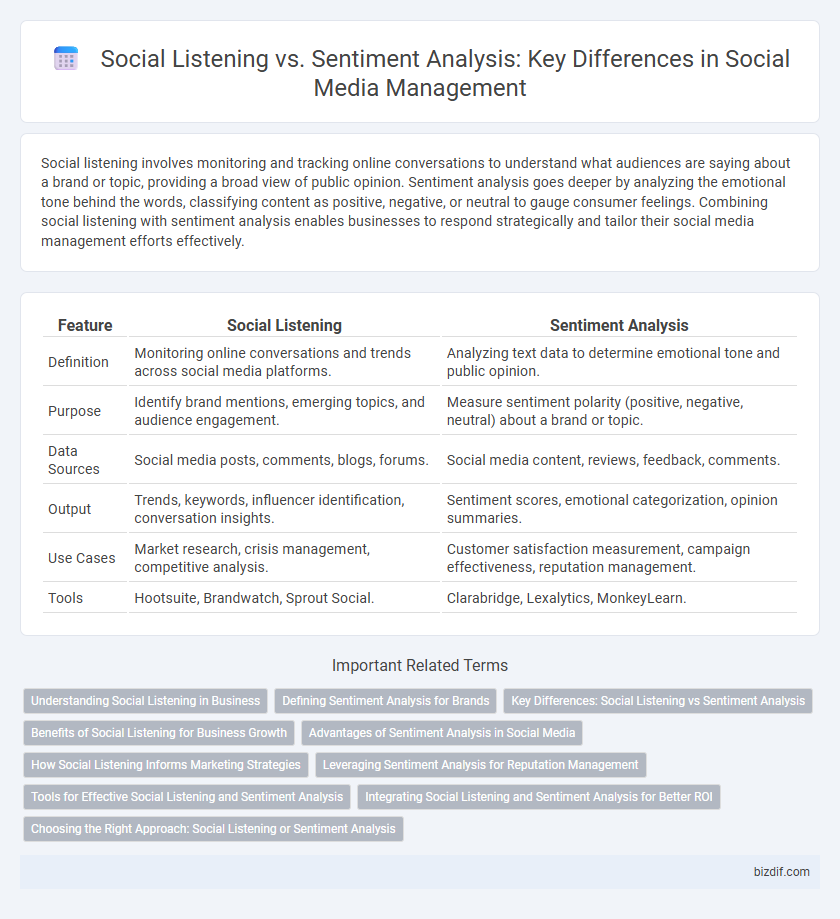Social listening involves monitoring and tracking online conversations to understand what audiences are saying about a brand or topic, providing a broad view of public opinion. Sentiment analysis goes deeper by analyzing the emotional tone behind the words, classifying content as positive, negative, or neutral to gauge consumer feelings. Combining social listening with sentiment analysis enables businesses to respond strategically and tailor their social media management efforts effectively.
Table of Comparison
| Feature | Social Listening | Sentiment Analysis |
|---|---|---|
| Definition | Monitoring online conversations and trends across social media platforms. | Analyzing text data to determine emotional tone and public opinion. |
| Purpose | Identify brand mentions, emerging topics, and audience engagement. | Measure sentiment polarity (positive, negative, neutral) about a brand or topic. |
| Data Sources | Social media posts, comments, blogs, forums. | Social media content, reviews, feedback, comments. |
| Output | Trends, keywords, influencer identification, conversation insights. | Sentiment scores, emotional categorization, opinion summaries. |
| Use Cases | Market research, crisis management, competitive analysis. | Customer satisfaction measurement, campaign effectiveness, reputation management. |
| Tools | Hootsuite, Brandwatch, Sprout Social. | Clarabridge, Lexalytics, MonkeyLearn. |
Understanding Social Listening in Business
Social listening in business involves monitoring online conversations across social media platforms to gather real-time insights about brand perception, customer preferences, and emerging trends. This process enables companies to identify opportunities, address potential issues proactively, and enhance customer engagement by understanding the broader context of consumer discussions. Unlike sentiment analysis, which quantifies emotional tone, social listening provides a comprehensive view of audience behavior and market dynamics essential for strategic decision-making.
Defining Sentiment Analysis for Brands
Sentiment analysis for brands involves using natural language processing (NLP) and machine learning algorithms to interpret and classify the emotions expressed in social media content. This technique helps brands gauge customer opinions, identify positive, negative, or neutral sentiments, and measure overall brand perception in real-time. By analyzing sentiment data, companies can make informed decisions to enhance customer engagement, manage reputation, and tailor marketing strategies effectively.
Key Differences: Social Listening vs Sentiment Analysis
Social listening monitors brand mentions and trends across social media platforms to identify consumer opinions and emerging topics in real-time. Sentiment analysis processes text data using natural language processing (NLP) to classify emotions as positive, negative, or neutral, providing quantifiable insights into audience mood. The key difference lies in social listening's broader scope for strategic monitoring versus sentiment analysis's specific focus on interpreting emotional tone within collected data.
Benefits of Social Listening for Business Growth
Social listening enables businesses to monitor brand mentions, track customer feedback, and identify emerging market trends in real-time, providing actionable insights to enhance customer experience and product development. By analyzing comprehensive conversations across social media platforms, companies can detect potential crises early and adjust marketing strategies to improve engagement and loyalty. Leveraging social listening fosters data-driven decisions that drive business growth and competitive advantage.
Advantages of Sentiment Analysis in Social Media
Sentiment analysis in social media allows brands to gauge customer emotions with precision, enabling more personalized marketing strategies and improved customer engagement. It provides real-time insights into public opinion by categorizing posts as positive, negative, or neutral, facilitating swift response to potential crises. This advanced analysis helps businesses enhance product development and optimize content by understanding audience preferences at scale.
How Social Listening Informs Marketing Strategies
Social listening gathers real-time data from social media conversations, allowing marketers to identify trending topics, customer pain points, and competitive insights. This data-driven approach informs targeted marketing strategies by highlighting audience preferences and emerging market demands. Unlike sentiment analysis, which quantifies emotions tied to specific content, social listening delivers a broad contextual understanding crucial for crafting effective campaigns and improving brand positioning.
Leveraging Sentiment Analysis for Reputation Management
Sentiment analysis enables brands to monitor and evaluate public emotions toward their products or services in real time, providing actionable insights that social listening alone may not fully capture. By leveraging natural language processing algorithms, companies can detect positive, negative, or neutral sentiments across social media platforms, allowing for strategic responses that protect and enhance brand reputation. Integrating sentiment analysis into reputation management helps businesses proactively address customer concerns, identify emerging issues, and maintain a positive public image.
Tools for Effective Social Listening and Sentiment Analysis
Tools for effective social listening and sentiment analysis include Brandwatch, Hootsuite Insights, and Sprout Social, which provide real-time monitoring and in-depth sentiment evaluation across multiple platforms. These tools utilize natural language processing (NLP) algorithms to detect positive, neutral, and negative sentiments, enabling brands to respond to customer feedback promptly. Integrating social listening with sentiment analysis tools enhances the ability to track brand reputation, identify emerging trends, and support data-driven marketing strategies.
Integrating Social Listening and Sentiment Analysis for Better ROI
Integrating social listening and sentiment analysis empowers businesses to capture real-time audience insights and accurately gauge customer emotions, driving more informed marketing strategies. Leveraging platforms like Brandwatch or Sprout Social enhances data accuracy by combining keyword tracking with nuanced sentiment scoring, which directly improves campaign targeting and customer engagement. This synergy maximizes ROI by enabling proactive responses to market trends and customer feedback, optimizing ad spend and boosting brand loyalty.
Choosing the Right Approach: Social Listening or Sentiment Analysis
Choosing between social listening and sentiment analysis depends on your social media management goals, as social listening offers comprehensive monitoring of brand mentions and industry trends, while sentiment analysis focuses on interpreting the emotional tone behind user comments. For real-time engagement and crisis management, social listening provides broader insights into audience conversations across platforms. Sentiment analysis is ideal for measuring public perception and evaluating campaign effectiveness through quantifiable emotional data, making each approach valuable based on specific business needs.
Social listening vs Sentiment analysis Infographic

 bizdif.com
bizdif.com